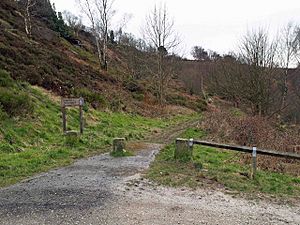Fox Hagg facts for kids
Fox Hagg is a cool nature reserve located in the Rivelin Valley in Sheffield, England. It's not huge, covering about 33.25 hectares (82.2 acres) of land. Two important waterways, the Allen Sike and the River Rivelin, flow through or near the reserve. The Wyming Brook Nature Reserve is right next door. A group called the Wildlife Trust for Sheffield and Rotherham takes care of Fox Hagg, making sure it's a great place for plants and animals.
Contents
What is Fox Hagg Made Of?
The rocky hillsides at Fox Hagg are made of different types of rock like sandstone, gritstone, and mudstone. These rocks were formed a very long time ago, during the Carboniferous period, which tells us the area was once a place with rivers. There's also a layer of peat, which is like really old, squashed plant material, that formed about three million years ago.
A Look Back in Time
People have lived in the Fox Hagg area for thousands of years, even during the Stone Age and Bronze Age. They started clearing trees to farm the land. During the Medieval Period, farming continued in the valley, but the steeper hills were used for grazing animals. Later, walls were built to mark off different areas of land.
Fox Hagg was once a "holly hagg." This means people would cut the soft, spikeless top leaves of holly trees to feed their sheep and cattle in winter. Today, the reserve is managed to protect wildlife and was officially made a local nature reserve in 2004.
Who Lives at Fox Hagg?
Lots of different animals call Fox Hagg home!
Amazing Birds
Many types of birds have been spotted here. You might see yellowhammers, common linnets, and bullfinches. Other birds like the song thrush and willow tit are also found here, and they are important because their numbers are decreasing in other places. Common birds like the Eurasian blackcap, common blackbird, and great tit are also easy to spot. Sometimes, bigger birds like ospreys and lapwings fly over the reserve.
Cool Reptiles and Amphibians
Keep an eye out for common toads hopping around, and you might even spot a viviparous lizard sunbathing on a rock.
Mammals You Might See
Surveys have shown that small mammals like voles, field mice, and tiny pygmy shrews live here. Grey squirrels are also common. If you're lucky, you might even see a roe deer visiting the reserve!
Tiny Invertebrates
Even the smallest creatures are important! Fox Hagg is home to some rare types of flies and beetles. The heather beetle is very common. You might also see the orange tip butterfly, which loves the marshy, wet areas of the reserve.
Plants and Trees at Fox Hagg
The reserve has a mix of different plant areas, making it a great place for many species.
Dealing with Invasive Plants
Sometimes, plants that aren't native to an area can take over and harm other plants. One example at Fox Hagg is Himalayan balsam (Impatiens glandulifera). People work to control it by cutting it down or pulling it out by hand.
Beautiful Woodlands
A big part of Fox Hagg is covered in broad-leaved woodland. You'll find lots of oak, birch, and rowan trees. In the wetter areas, alder and willow trees grow well.
Heathland Areas
About 4.8 hectares (12 acres) of the reserve is heathland. This area is mostly covered in bilberry plants, along with bracken, brambles, and wavy hair-grass.
Visiting Fox Hagg
Fox Hagg is easy to explore! There are many public paths, including footpaths for walking and bridleways for horses. You can park your car at the Lodge Lane entrance, where there's space for about five vehicles. More parking is available near the Rivelin Dams, which is just to the north-west of the reserve. The local council helps keep an eye on the reserve to make sure it stays a great place for nature.
Fox Hagg in Art
The beautiful hillsides of Fox Hagg have even inspired artists! In 1941, an artist named Lionel Maurice de Sausmarez painted the area. Another artist, W. E. Smith, painted the valley from a viewpoint overlooking the reserve around c. 1966.


